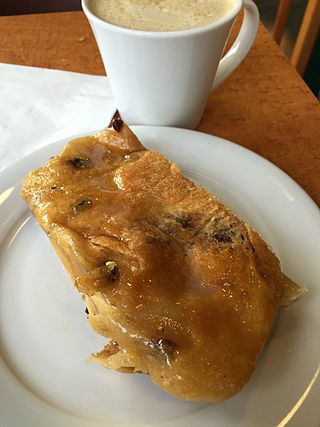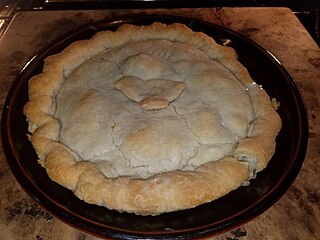
Cake is a flour confection made from flour, sugar, and other ingredients and is usually baked. In their oldest forms, cakes were modifications of bread, but cakes now cover a wide range of preparations that can be simple or elaborate and which share features with desserts such as pastries, meringues, custards, and pies.

A doughnut or donut is a type of food made from leavened fried dough. It is popular in many countries and is prepared in various forms as a sweet snack that can be homemade or purchased in bakeries, supermarkets, food stalls, and franchised specialty vendors. Doughnut is the traditional spelling, while donut is the simplified version; the terms are used interchangeably.

Gooey butter cake is a type of cake traditionally made in St. Louis, Missouri. It is a flat and dense cake made with wheat cake flour, butter, sugar, and eggs, typically near an inch tall, and dusted with powdered sugar. While sweet and rich, it is somewhat firm, and is able to be cut into pieces similarly to a brownie. Gooey butter cake is generally served as a type of coffee cake and not as a formal dessert cake. There are two distinct variants of the cake: the original St. Louis, MO Bakers' gooey butter and a cream cheese and commercial yellow cake mix variant. The original St. Louis, MO Bakers' gooey butter is believed to have originated in the 1930s. It was made with a yeast-raised sweet dough on the bottom.

Ukrainian cuisine is the collection of the various cooking traditions of the people of Ukraine, one of the largest and most populous European countries. It is heavily influenced by the rich dark soil (chornozem) from which its ingredients come, and often involves many components. Traditional Ukrainian dishes often experience a complex heating process – "at first they are fried or boiled, and then stewed or baked. This is the most distinctive feature of Ukrainian cuisine".

Pennsylvania Dutch cuisine is the typical and traditional fare of the Pennsylvania Dutch. According to one writer, "If you had to make a short list of regions in the United States where regional food is actually consumed on a daily basis, the land of the Pennsylvania Dutch—in and around Lancaster County, Pennsylvania—would be at or near the top of that list," mainly because the area is a cultural enclave of Pennsylvania Dutch culture.

Potato bread is a form of bread in which potato flour or potato replaces a portion of the regular wheat flour. It is cooked in a variety of ways, including baking it on a hot griddle or pan, or in an oven. It may be leavened or unleavened, and may have a variety of other ingredients baked into it. The ratio of potato to wheat flour varies significantly from recipe to recipe, with some recipes having a majority of potato, and others having a majority of wheat flour. Some recipes call for mashed potatoes, with others calling for dehydrated potato flakes. It is available as a commercial product in many countries, with similar variations in ingredients, cooking methods, and other variables.

Lángos is a typical Hungarian food. Today it is a deep fried flatbread, but in the past it was made of the last bits of the bread-dough and baked at the front of the brick or clay oven, to be served hot as the breakfast of the bread-baking day.

A buñuelo (Spanish:[buˈɲwelo], alternatively called boñuelo, bimuelo, birmuelo, bermuelo, bumuelo, burmuelo, or bonuelo, is a fried dough fritter found in Spain, Latin America, and other regions with a historical connection to Spaniards, including Southwest Europe, the Balkans, Anatolia, and other parts of Asia and North Africa. Buñuelos are traditionally prepared at Christmas. It will usually have a filling or a topping. In Mexican cuisine, it is often served with a syrup made with piloncillo.

Kue is an Indonesian bite-sized snack or dessert food. Kue is a fairly broad term in Indonesian to describe a wide variety of snacks including cakes, cookies, fritters, pies, scones, and patisserie. Kue are made from a variety of ingredients in various forms; some are steamed, fried or baked. Kue are popular snacks in Indonesia, which has the largest variety of kue. Because of the countries' historical colonial ties, Koeé (kue) is also popular in the Netherlands.

Lardy cake, also known as lardy bread, lardy Johns, dough cake and fourses cake, is a traditional rich spiced form of bread found in several southern counties of England, each claiming to provide the original recipe. It remains a popular weekend tea cake in the southern counties of England, including Sussex, Surrey, Hampshire, Berkshire, Wiltshire, Dorset and Gloucestershire.

Monkey bread is a soft, sweet, sticky pastry served in the United States for breakfast or as a treat. It consists of pieces of soft baked dough sprinkled with cinnamon. Often a midmorning/breakfast food. It is often served at fairs and festivals.

Bread is a staple food of Finland. It is served with almost every meal and many different types are produced domestically.

Fastnacht Day is an annual Pennsylvania Dutch celebration that falls on Shrove Tuesday, the day before Ash Wednesday. The word translates to "Fasting Night" or “Almost Night” in English. The tradition is to eat the very best foods, which are part of the German tradition, and much of them, before the Lenten fast. Fastnachts are similar to doughnuts. There are three types of Fasnacht, one made with yeast, one made with baking powder, and one made with potatoes and yeast. All are slightly crispy on the outside and not as sweet as doughnuts.

Swabian cuisine is native to Swabia, a region in southwestern Germany comprising great parts of Württemberg and the Bavarian part of Swabia. Swabian cuisine has a reputation for being rustic, but rich and hearty. Fresh egg pastas, soups, and sausages are among Swabia's best-known types of dishes, and Swabian cuisine tends to require broths or sauces; dishes are rarely "dry".

Wähe is a baked dish typical of Swiss and Alemannic (German) cuisine. A wähe consists of a casing and a topping of a custard enveloping either fruit, vegetables or cheese. The custard and fruits or vegetables are baked together. The preparation is thus very similar to that of the French quiche or tarte.

Moravian chicken pie is a savory meat pie that originated in the colonial town of Salem, North Carolina. It is a traditional double crusted pie made with flaky shortcrust pastry filled with only chunks of poached chicken meat and a thick broth-based sauce. Unlike chicken pot pies, vegetables are never included in the filling. The pie is served in slices with hot chicken gravy on top, and extra gravy on the side. Mashed potatoes are a common accompaniment.

C. Winkler Bakery is a bakery on South Main Street in Old Salem, North Carolina. Now the oldest continually operating bakery in North Carolina, it was established in 1799 by the Moravian Church, and is named for Christian Winkler, a Swiss-born baker, who began working there in 1807, after replacing original baker Thomas Butner Jr. The building, which now has a landmark designation, was constructed by Salem's master builder and mason Johann Gottlob Krause, shortly before his death. Its first story is built of uncut stone; the upper levels, of hand-made brick.

















